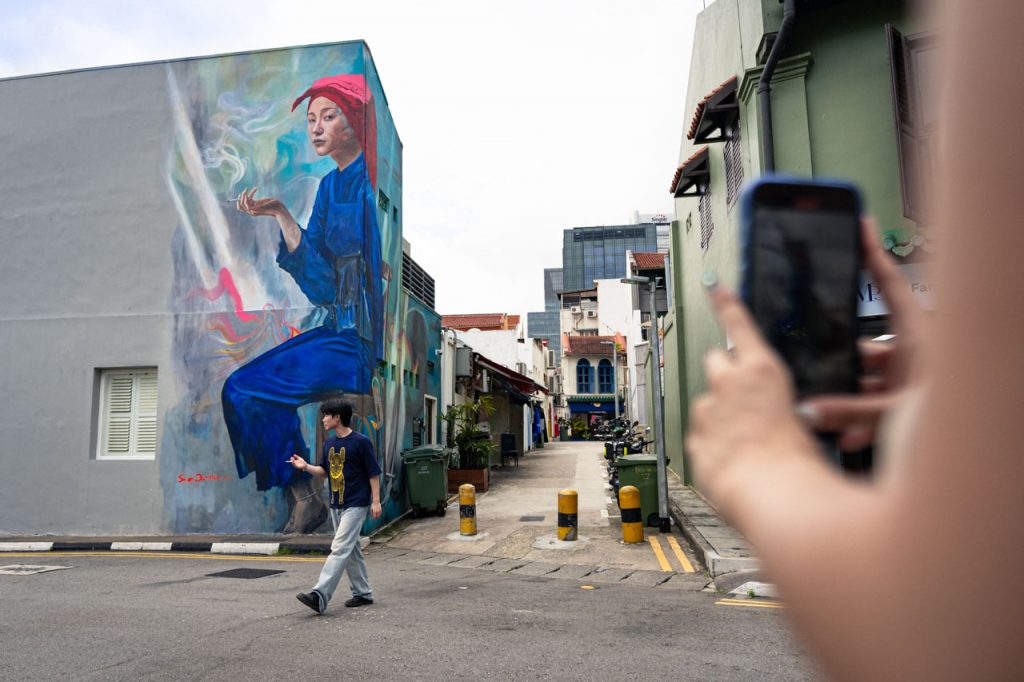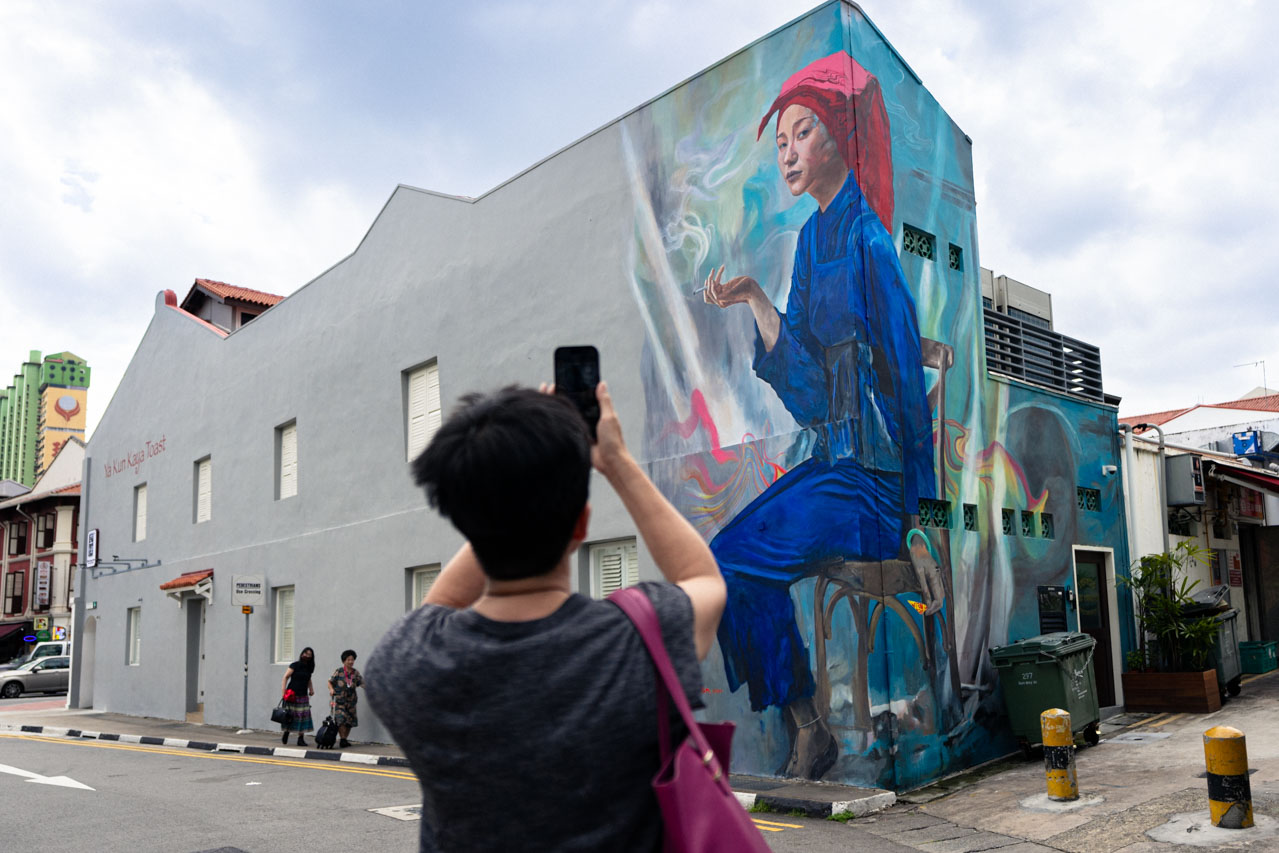All images by Stephanie Lee for RICE Media unless stated otherwise.
Over the weekend, a woman and her cigarette became the subject of debate.
A mural on a Chinatown shophouse featuring a youthful jade-bangled samsui woman, perched on a wooden chair, toting a cigarette, recently caught the attention of the Urban Redevelopment Authority (URA) as it apparently ran counter to the Singapore government’s anti-smoking policies.
This was despite the fact that samsui women, who mainly worked as construction labourers, frequently smoked—one of the few respites in their famously frugal lives.
URA told the landlord to erase the cigarette in the mural and public outcry predictably ensued, The Straits Times reported on June 21.
The Singapore-based American artist who’d painted the mural, Sean Dunston, also alleged that URA, in their feedback to the landlord, had cited a comment from an unnamed member of the public which called the mural “offensive” and said the woman “looks more like a prostitute than a hard-working samsui woman”. There’s a lot to unpack there, but I’ll save that for later.
URA then ignominiously walked back on its decision, saying it would review its stance after taking into account the additional feedback. While it deliberates, the mural and her cigarette get to stay.
Even as it has yet to reach its conclusion, this debacle has raised questions about our knee-jerk response to complaints. What do we lose when the loudest voices find offence in the innocuous?

On Stereotypes and Preconceived Notions
Not liking the artwork isn’t the problem here. The bigger issue is the entitlement of trying to get something taken down simply because you didn’t like it.
As more people caught wind of the mural, it became clear that—as with any artwork—it had its fans and detractors. It wasn’t just the cigarette that some people found objectionable. It was apparently the samsui woman’s gaze and the upturned grasp of her cigarette.
She was holding it in “a glamorous way”, AWARE Singapore claimed when they weighed in on the topic on social media. The women’s rights advocacy group said the portrayal might perpetuate the male gaze.
Likening the woman in the mural to a prostitute—and using the word as an insult—is an extremely damaging take, AWARE Singapore added. Indeed, it’s ironic that the unnamed member of the public, in calling for more respect to be shown to our samsui women, managed to disrespect sex workers and perpetuate misogyny in one fell swoop.
At the same time, other members of the public saw no issue with the mural, even sharing photos of actual samsui women to prove its historical accuracy.

The facts are, these samsui women were young when they came over from China to work. They did smoke. It’s not a stretch to say that Dunston’s samsui woman mural is a pretty reasonable depiction. But why does this particular portrayal of a samsui woman make some uncomfortable?
Sure, the artist is an American man. And the topic of men creating artwork to cater to the male gaze isn’t new. But I’m not sure if that’s the point here.
It isn’t as if the samsui woman dressed or posed in a vulgar manner, nor is she sporting a full face of makeup. All she’s doing is sitting and enjoying a smoke. Can a woman not do that without being sexualised or seen as trying to appeal to the male gaze? What even is a “glamourous” way of holding a cigarette? Must a female labourer always be portrayed as elderly and devoid of all femininity?
A part of the discomfort some Singaporeans are feeling also stems from the fact that we simply aren’t used to seeing samsui women portrayed in this way. We’re used to the monolithic representation of the samsui woman in our media: old, withered, exhausted.
The image of samsui women has been appropriated in various ways to champion desirable values such as hard work, thrift, resilience, and perseverance, says Remembering the Samsui Women author Kelvin E.Y. Low.
Beyond their media portrayal as industrious pioneers then and elderly women in need of help now, there are other ways to remember their lives and experiences. For what it’s worth, Dunston, the mural artist, did say that was his intent.
Speaking to The Straits Times, he explained: “Normally, samsui women are portrayed as old women—but when they came to Singapore, they were young and you don’t really see that kind of depiction. I thought it would be nice to change it up to show a younger woman and catch them in a situation when they were not working.”
If we really care about these women’s history, why are we—well, mainly just that anonymous complainant—trying to censor a historically accurate aspect of their life and sanitise it to fit our idea of them?
Perhaps we’re so used to seeing a PG version of our history that being faced with something outside the typical narrative is enough to offend people.

What URA Could Have Done Better
To be fair, it’s not surprising that the mural caught the authorities’ attention. All proposals for murals on conserved buildings should be submitted to the building owner and URA for prior approval, the statutory board told CNA. The artist in this case hadn’t done that for the mural, which was completed in early April.
The proposal was submitted on April 19, after completion. URA had flagged the smoking in the mural as an issue on May 8, but the artist did not submit a new proposal by the stated May 22 deadline.
But if URA’s issue with the mural was solely the depiction of smoking, why did it have to highlight the “prostitute” message in its email to the artist? The feedback was inaccurate, hyperbolic, and misogynistic.
What purpose was sharing it supposed to achieve? By passing this feedback on to the landlord as if it was valid, was URA not lending the complaint some legitimacy?

Their stance of requiring murals to align with government policy is also debatable. Current legislation only prohibits tobacco advertisements and promotion.
As Dunston told The Straits Times: “It’s good to have boundaries, but a generic template for enforcing rules on art is damaging. The policy stance on cigarettes is well founded if it’s an advertisement, endorsement or advocation. This mural is not any of those.”
Popular mural artist Yip Yew Chong agreed, writing on his Instagram account that painting a samsui woman taking a smoke break, as they used to do, is by no means promoting smoking.
Yip, who’s known for his large-scale nostalgic murals, also revealed that he’d originally intended for his mural at Thian Hock Keng Temple to include coolies smoking opium. However, after consulting with the authorities and stakeholders, he decided to change it to coolies cooking on their bunk beds instead.
It’s not as if seeing a historical depiction of coolies smoking opium would encourage viewers to try smoking opium. Sanitising our history to such an extent is obviously overkill.
If conflicting public complaints can prompt the URA to reevaluate its decision, it might be a good opportunity for them to clarify how they determine whether public feedback is worth acting on. This applies not just to the URA—all government bodies would benefit from building public trust through greater transparency behind drastic decisions.
Realistically, we can never be rid of censorship. But it should be based on solid parameters and principles rather than hasty reactions to whoever complains the loudest.
Complaint Culture
This whole incident is reminiscent of the recent Science Centre kerfuffle, where a planned talk on gender and sex was nuked after conservatives’ complaints. We could have had a productive, educational discussion at the Science Centre, but now we’ll never know.
Are we too reactive to complaints, to the point where we stifle discourse? Of course, lines should be drawn when content or art is truly offensive. For example, if it’s outrightly demeaning towards a group of people.
But allowing content that sparks debate isn’t a bad thing. Take this mural for example. It’s already created conversations on historical accuracy, morality, sexuality, and gender stereotypes.
Pandering to a vocal group that takes offence to minor things might be the safe route. After all, if someone complains about something, just act on it, and the complaints will likely disappear. Problem solved. That’s Singaporean efficiency for you.
But we have to consider what we lose in the process—vibrant, nuanced, thought-provoking discussions.
Art serves as a mirror to society—this includes the good, bad and ugly. How can we have a thriving cultural scene if we only want the sanitised, wholesome bits of our history represented in our historic buildings?
Some complaints are reasonable. Some, like the “prostitute” complaint, clearly aren’t. We can only hope that people can learn the difference.






